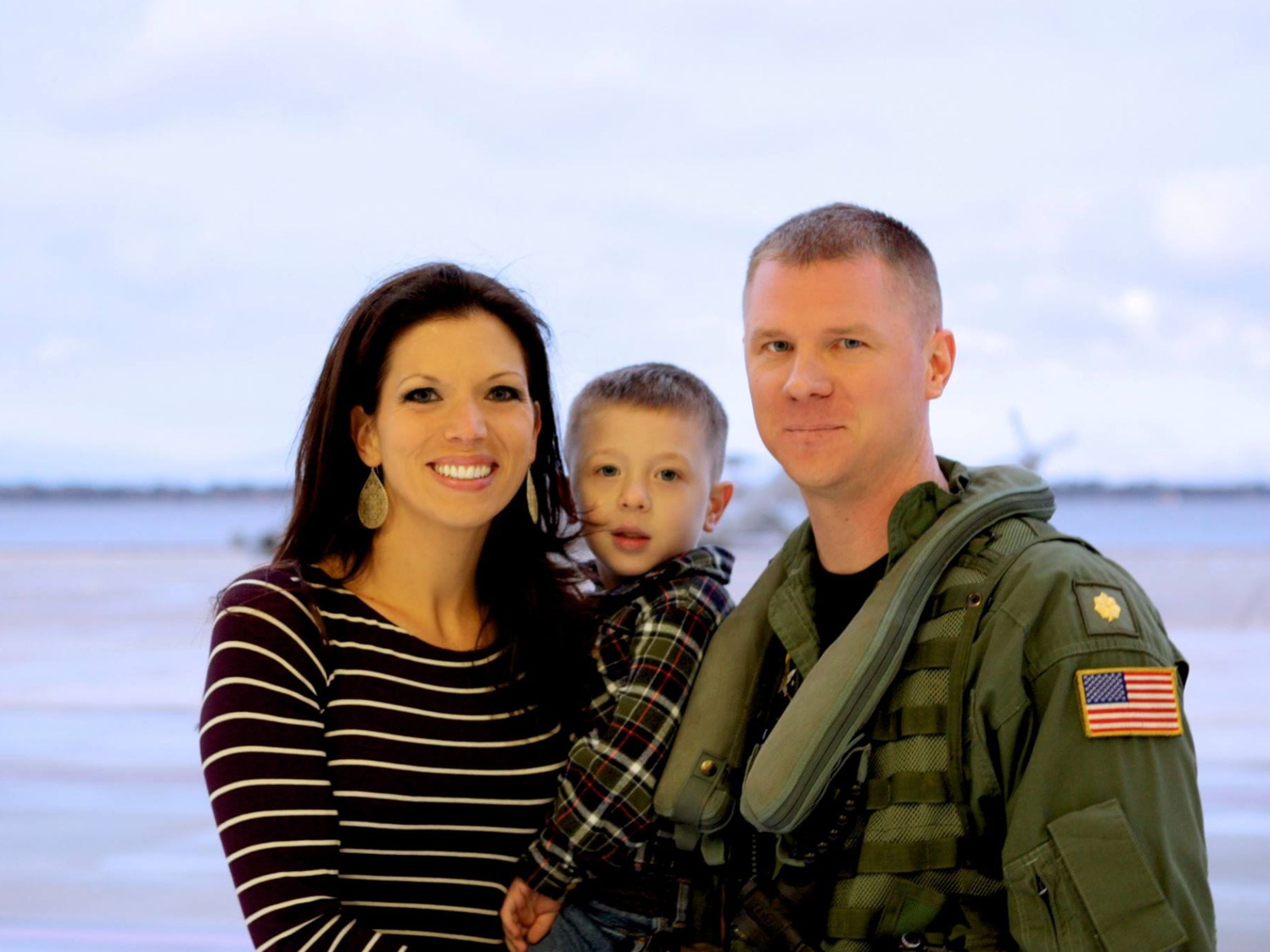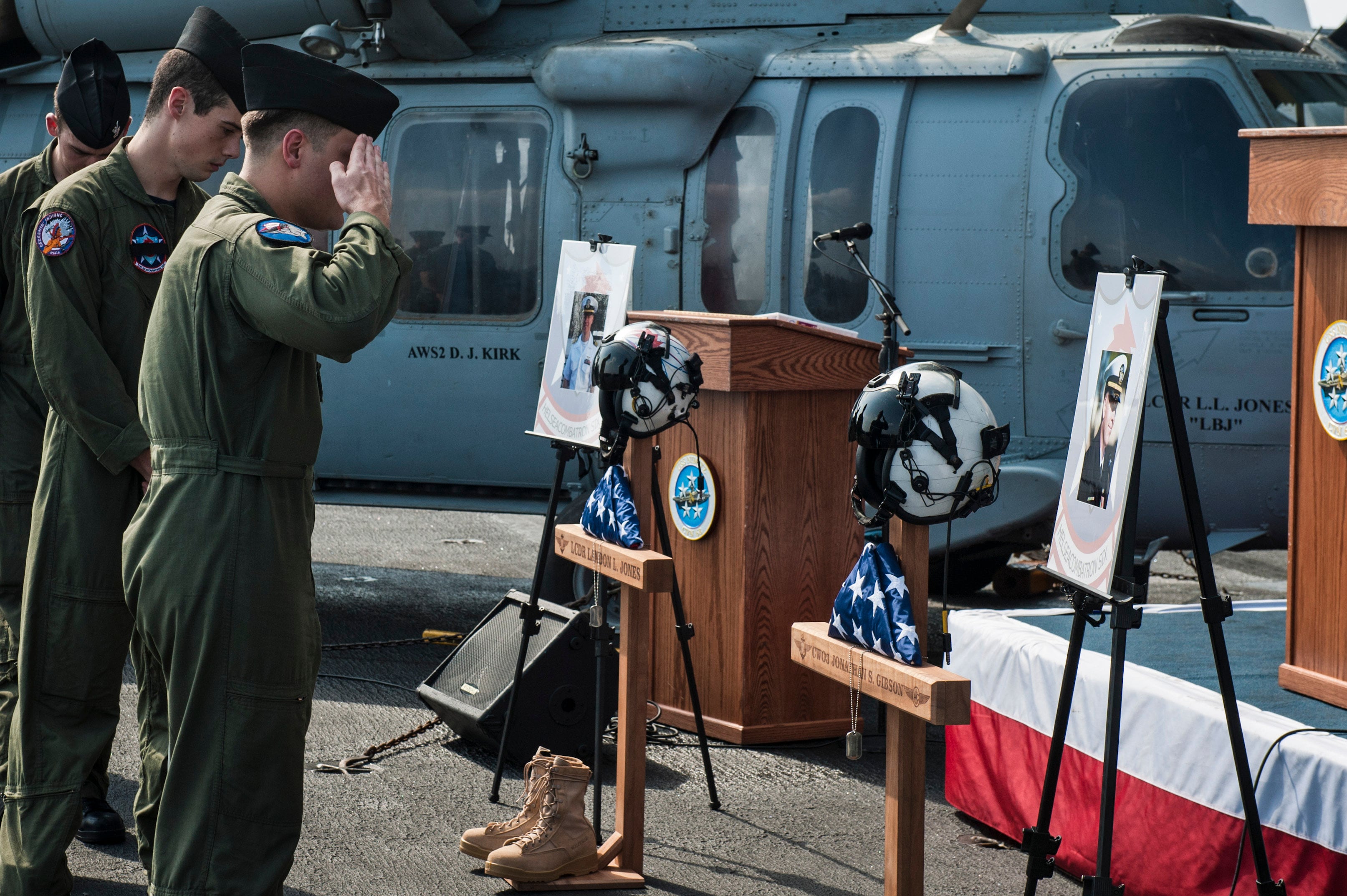The widows of two helicopter pilots tragically lost at sea in September 2013 when a wave washed their aircraft off the flight deck of the destroyer William P. Lawrence have filed a lawsuit against the Navy, arguing that the accident that tore their husbands' still spinning helicopter off a destroyer's flight deck was foreseeable and caused by a well-known defect in the design of the DDG Flight IIA.
Theresa Jones and Christina Gibson argue that the accident was caused by the flight deck's low freeboard (the distance from the deck to the waterline) and that the service Navy ignored more than a dozen hazard reports over the years that warned of the dangers posed by the a low flight deck, estimated at only seven feet above the water at the time of the mishap aboard the destroyer William P. Lawrence.
"Between January 2003 and March 2013 … the Navy documented at least nine other mishaps involving waves washing over destroyer flight decks," the complaint reads. "This systemic disregard for the safety of its personnel and equipment places the culpability for the deaths of these two pilots, husbands and fathers squarely on the shoulders of the Navy and the designers and builders of these ships."
The arguments set forth in the lawsuit mirror the main findings of a Navy Times investigation that found showed that aviators had repeatedly warned for years that destroyer the DDG's flight decks arewas hazardous, and but that the Navy failed to act until the deaths of Lt. Cmdr. Landon Jones and Chief Warrant Officer 3 Jonathan Gibson.
The suit is seeking compensation for the pain and suffering of the widows and their families, but also seeks a court order that would force the Navy to warn pilots and operators of the ships of the dangers of the low-freeboard flight deck, but. The suit, seen as a long-shot case, would It would also compelforce the Navy to spend millions to raise destroyer flights decks to make them safer. replace the flight decks and raise the freeboard to make them more safe.
The lawsuit will have to surmount faces strong headwinds, however, because the Feres Doctrine, a controversial precedent established by the Supreme Court that explicitly a 1950 Supreme Court decision, specifically shields the military and its commanders from liability suits to avoid a situation where commanders can get sued for issuing orders that result in death and injury. News of the lawsuit's filing in the Southern District of California federal court was first reported by the San Diego Union Tribune newspaper.

Theresa Jones, the widow of deceased helicopter pilot Lt. Cmdr. Landon Jones, is moving forward with a lawsuit against the Navy arguing that negligence by the Lawrence crew and Navy officials caused her husband's death.
Photo Credit: Courtesy of Theresa Jones
The widows' attorney Brian Lawler, a former Marine F/A-18 Hornet pilot, said in a Sept. 22 phone interview that he was seeking to carve out an exception to Feres, and that this case would be compelling because of a clear pattern of negligence on the Navy's part of the Navy.
"In addition to compensating the families for the loss of their husbands and fathers, the Navy should change the design of the flight deck," Lawler said in a Sept. 22 phone interview. "Thirteen HAZREPs over 20 years, and an additional nine mishap reports, without any substantial changes? At what point do they change the way they do business?"
The suit is seeking damages from names the Navy; shipbuilders Huntington Ingalls Industries and Bath Iron Works; naval architecture firm Gibbs & Cox, which designed the ship; (the company that designed the ship), and Cmdr. Jana Vavasseur, who was the captain of the Lawrence during the accident, as the defendants, for alleged negligence that caused the accident.
A Navy spokesman declined to comment on the lawsuit.

Aircrews pay their respects at a memorial for Jones and Gibson held aboard the carrier Nimitz on Oct. 1, 2013, in 5th Fleet.
Photo Credit: MC3 Raul Moreno Jr./Navy
But Theat lawsuit faces long odds, experts said.
"I'd say they have a vanishingly small chance of getting any traction on this," said Eugene Fidell, a former Coast Guard Judge Advocate and noted military law expert who teaches at Yale, saying that the Supreme Court has established clear support for Feres over the years, despite some heart-rending cases that have risen to its level.
In 2011, the Supreme Court refused to take up the case of Air Force Staff Sgt. Dean Witt, who was left in a permanent vegetative state after a botched appendectomy at the hands of an Air Force doctor.
The widows' suit also names the Department of Veterans Affairs and Prudential Insurance on behalf of Jones, who claims the VA did not notify her that her deceased husband had canceled his Serviceman's Group Life Insurance prior to his accident, as is required by the policy. Prudential is the company that underwrites the VA's life insurance policies.
The suit seeks a $400,000 settlement from the VA and Prudential, the limits of the SGLI she would have received if the SGLI had been active.
Correction: A previous version of this article erroneously stated that Theresa Jones filed for personal bankruptcy. She did not. Navy Times regrets the error.
David B. Larter was the naval warfare reporter for Defense News.





